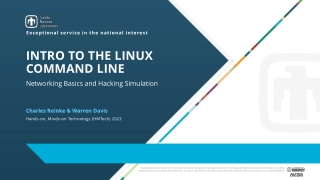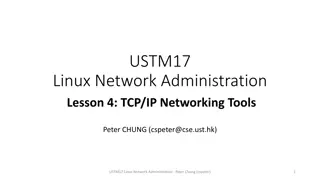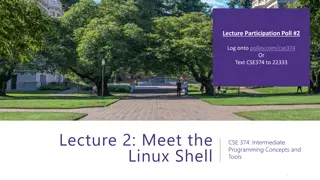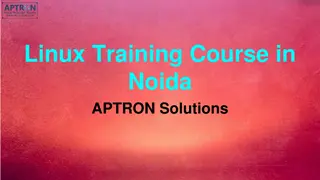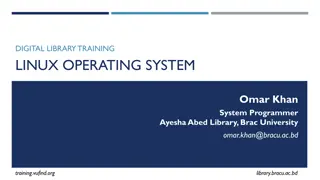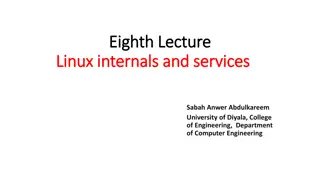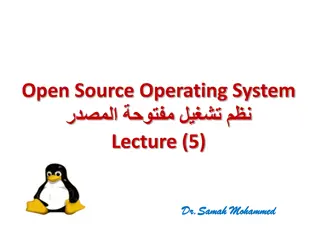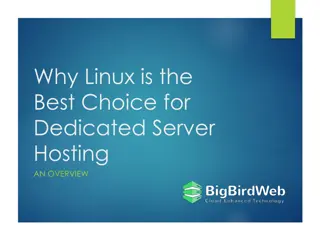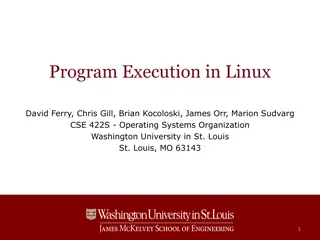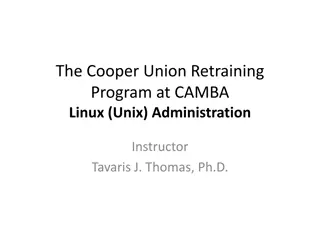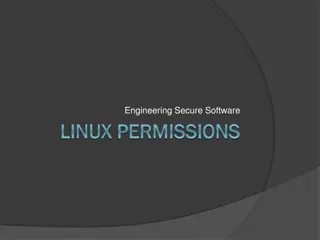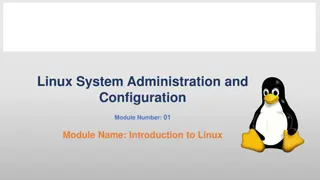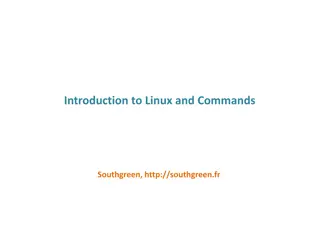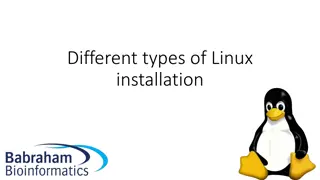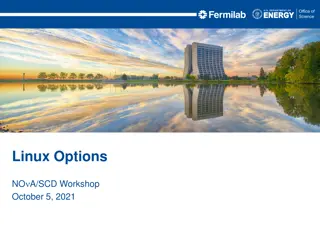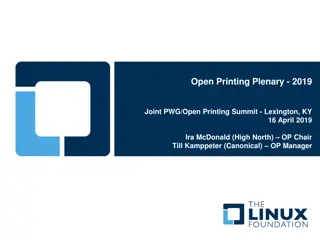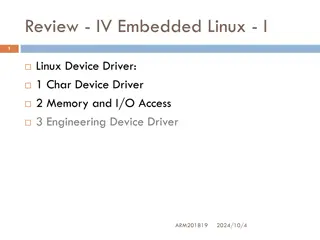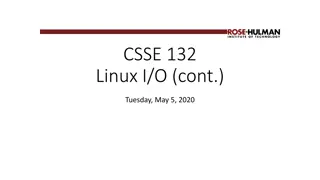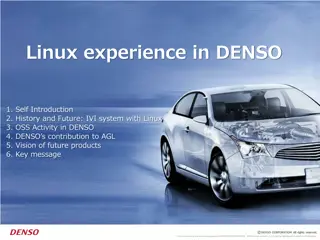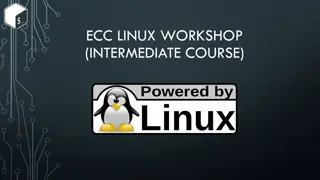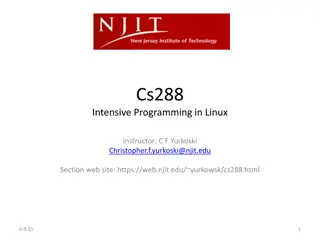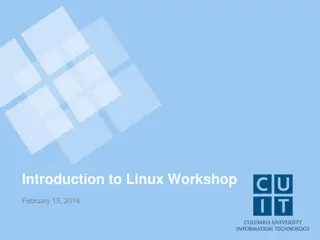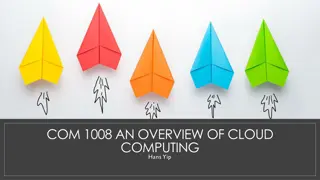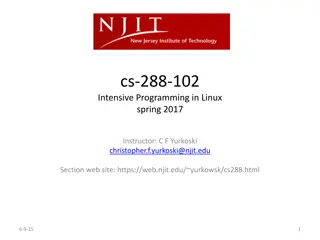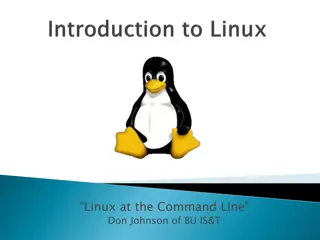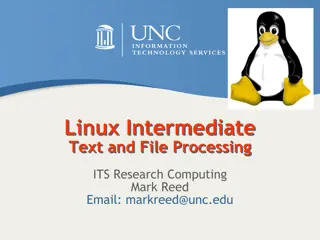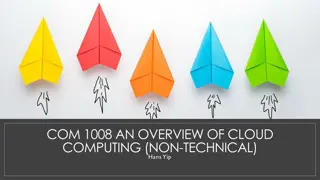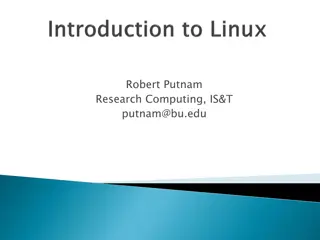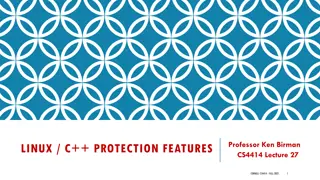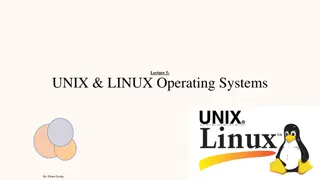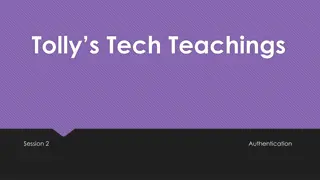Introduction to Linux Command Line
The significance of the command line interface in computing, understand why it is preferred for efficient file management, and discover Linux as an alternative operating system widely utilized on servers and supercomputers. Learn how to access a Linux server via SSH for practical application.
1 views • 14 slides
Stack Based Attacks in Linux (an intro)
Explore the world of stack-based attacks in Linux through an introductory session presented by Bryce L. Meyer at the Saint Louis Linux Users Group. Covering topics from weaknesses to exploits, shellcode, and mitigations like stack canaries and address space randomization, this overview delves into c
7 views • 60 slides
Introduction to Bash Shell Programming
Learn about the fundamentals of shell programming in Unix/Linux systems, including the role of the shell as an interface between users and the operating system. Understand the components of a shell, such as the kernel, and explore different types of shells like Bourne Shell and C Shell. Discover how
6 views • 17 slides
Understanding TCP/IP Networking Tools in Linux Administration
The iproute2 software suite in Linux provides utilities for network control and monitoring, replacing legacy tools like ifconfig, netstat, route, and arp. This lesson delves into displaying information about network interfaces, network addresses (IP addresses), routing tables, assigned DNS servers,
2 views • 22 slides
Introduction to Linux Shell for CSE 374 Course
Explore the Linux shell basics in CSE 374 course, covering topics like using Bash shell, executing commands, connecting to remote Linux servers, and interaction basics such as navigating command history. Get ready to dive into text-based interfaces and command-line operations in a Unix environment.
0 views • 14 slides
Linux Training Course in Noida
At APTRON Solutions, we prioritize practical learning with real-world scenarios, ensuring you develop the confidence to tackle complex challenges in Linux Training Course in Noida environments. Whether you're aiming to become a Linux administrator or
2 views • 9 slides
Decision Analysis and Operations Research in Management
This content delves into Management Decision Analysis and Operations Research techniques such as Linear Programming, Integer Linear Programming, Dynamic Programming, Nonlinear Programming, and Network Programming. It covers the phases of an Operations Research study, mathematical modeling for decisi
0 views • 36 slides
Linux Course Overview and Content for Digital Library Training
Explore the world of Linux operating systems in the context of digital library training, covering topics such as Linux distributions, system administration, text manipulation, file systems, and network configuration. The course provides a comprehensive overview and detailed content modules to develo
1 views • 11 slides
Understanding Linux Services and Internals
Explore the components of a Linux system, including hardware controllers, the Linux kernel, operating system services, user applications, directory structure, shells, and essential Linux services. Learn how to list services in Linux by connecting via SSH and accessing them as a root user to manage c
1 views • 14 slides
Introduction to Linux Shell Scripting
Dive into the world of Linux shell scripting with a focus on the bash shell. Explore the basics of programming versus scripting, different shells available in Linux, common scripting errors, and the essential elements of writing shell scripts in Linux.
0 views • 26 slides
Introduction to Linux System Administration
Explore the essentials of Linux system administration in this course material. Learn how to access Linux servers and virtual machines, utilize SSH for secure connections, and configure Kali Linux VM settings for efficient usage. Gain hands-on experience with graphical and command-line interfaces to
0 views • 45 slides
Why Linux is the Best Choice for Dedicated Server Hosting
Why Linux is the Best Choice for Dedicated Server Hosting\nWhen it comes to dedicated server hosting, choosing the right operating system is crucial for performance, security, and scalability. Among the available options, Linux stands out as the pref
0 views • 10 slides
Understanding Program Execution in Linux
Explore the process of program execution in Linux, including details on the ELF executable file format, creating executable files, static vs. dynamic linking, and the impact of linking on executable sizes. Learn about compilation, linking, and the differences between static and dynamic linking in th
2 views • 17 slides
Linux Administration Essentials: A Comprehensive Training Program
Join the Cooper Union Retraining Program at CAMBA for an intensive course on Linux (Unix) Administration instructed by Dr. Tavaris J. Thomas. Learn core objectives spanning from file system management to network configuration without diving into hacking or programming. Explore the history of Linux,
0 views • 35 slides
Understanding Linux File Permissions and Security Practices
Explore how Linux file permissions work, including the concepts of read, write, and execute permissions for files and directories. Learn about changing permissions using the `chmod` command and how umask affects default permissions when creating files. Enhance your understanding of securing software
0 views • 9 slides
Overview of the Linux Boot Process
Exploring the six stages of the Linux boot process, starting from the BIOS and Master Boot Record (MBR) to the Grand Unified Bootloader (GRUB) and kernel initialization. Understand the essential components involved in booting up a Linux system, from system integrity checks to mounting the root file
0 views • 18 slides
Introduction to Linux System Administration
Explore the fundamentals of Linux system administration, including accessing Linux systems, using SSH for secure connections, setting up virtual machines, understanding the Unix system kernel and shell, and grasping the multi-user and multi-process aspects of Unix. Enhance your skills in managing Li
0 views • 42 slides
Introduction to Linux and Commands - Overview and Benefits
Linux is a powerful operating system with roots in UNIX, offering a wide array of functionalities for users. The program goals include presenting the Linux OS basics, introducing fundamental command-line operations, and showcasing the utilization of bioinformatics software. The content explores the
0 views • 79 slides
Exploring Computer Programming Principles
Dive into the world of computer programming, covering high-level and machine languages, compilers, interpreters, writing programs, top-down design, and the array of programming languages available. Understand the essentials of building code to control computers, the diversity of programming language
0 views • 23 slides
Introduction to Linux: Course Overview and Objectives
This introduction to Linux course provides a comprehensive overview of operating systems, including the history, variations, user interface, and essential commands. The course is designed with lectures, labs, and exercises to help participants gain a better understanding of Linux and its practical a
0 views • 77 slides
Different Types of Linux Installation Methods
This detailed guide covers various methods for installing Linux, including on bare metal/physical hardware, through CD/DVD/USB/network, in a virtual machine, and on cloud services like Amazon EC2. It explains the differences between live image installations and guided installations, as well as provi
0 views • 12 slides
Evaluation of Linux Distribution Options by CERN and Fermilab
CERN and Fermilab are evaluating Linux distribution options and have decided to target CentOS Stream 8 as the standard distribution for experiments. Red Hat has proposed an academic licensing scheme, but concerns exist about its applicability. CentOS Stream 8 is considered low risk and has been runn
0 views • 6 slides
Linux Printing Technologies Overview
Delve into the world of Linux printing with insights on open printing plenary sessions, Linux distribution market shares, driverless printing support, CUPS filters development, and future trends. Explore the growing popularity of Linux in various sectors and witness the advancements in driverless pr
0 views • 13 slides
Understanding Embedded Linux Device Drivers for ARM Architecture
Explore the intricate world of Linux device drivers with a focus on ARM architecture. Delve into topics like character device drivers, memory and I/O access, block device drivers, and various other driver types. Gain insights into the principles and workings of LCD drivers, IIC drivers, network driv
0 views • 123 slides
Understanding Linux I/O Concepts and Practices
Delve into the world of Linux I/O by exploring topics such as unbuffered and buffered I/O operations, file representations, performance comparisons, and practical exercises. Learn to utilize functions like fwrite, fread, fopen, fclose, fseek, ftell, and fgets in C programming for efficient input/out
0 views • 7 slides
In-Vehicle Infotainment System Evolution at DENSO: A Linux Experience
Explore Kazuo Tsubouchi's journey at DENSO, from software engineer to General Manager of ICT Division, focusing on Linux-based IVI systems. Witness DENSO's transition to Linux in car navigation, joining Linux Foundation and GENIVI, contributing to AGL, and shaping the future of in-vehicle technology
0 views • 20 slides
Intermediate Linux Workshop Overview
This intermediate Linux workshop covers various topics including input, output, pipes, processes, compiling Unix software packages, symbolic and hard links, environment variables, security, and ECC policies. It also explains CougarNet authentication for accessing engineering Linux systems, setting u
0 views • 34 slides
CS288 Intensive Programming in Linux - Course Updates and Homework Review
In CS288 Intensive Programming in Linux, Professor C.F. Yurkoski shared announcements regarding TA contact info, a sneak peek at upcoming quizzes, and file editing tips. The course also covered evaluation quiz results and practical exercises using tools like vi and tr. Homework assignments focused o
0 views • 35 slides
Introduction to Linux Workshop and History: A Brief Overview
Delve into the world of Linux with an introduction to its basics, operating system functionalities, and a quick history lesson from the Unix roots to the release of Linux. Explore the significance of Linux as an operating system and the evolution of computing. Get insights into key milestones like U
0 views • 98 slides
Overview of Windows Subsystem for Linux 2 (WSL2)
Windows Subsystem for Linux 2 (WSL2) is a new feature in Windows 10 that enables users, especially developers, to run native Linux command-line tools directly on Windows alongside traditional desktop applications. WSL provides a way to use Bash, common Linux tools, and Linux-first tools on Windows,
0 views • 11 slides
Introduction to Linux: Key Aspects and Application in Robotics
Discover the significance of Linux in the world of robotics and beyond. Learn about its widespread usage, versatility under the GNU GPL license, robust security features, and practical application through executing bash scripts on a Linux system. Dive into the fundamentals of Linux Shell interaction
0 views • 21 slides
CS 288-102 Intensive Programming in Linux Spring 2017 Course Details
Learn Linux programming, C language proficiency, Bash scripting, and more in this intensive course taught by Instructor C.F. Yurkoski. The course covers programming in Linux environment, command line interface, C language, client/server programming, and essential programming concepts like pointers,
0 views • 31 slides
Introduction to Linux at the Command Line with Don Johnson
Dive into the world of Linux with Don Johnson from BU IS&T. Learn about Linux's origins, common OS used by researchers, GNU utilities, essential commands, file systems, network tools, and more. Discover the importance of xterm emulation software and Mac OS X Terminal in this comprehensive guide to m
0 views • 30 slides
Comprehensive Guide on Linux Intermediate Text and File Processing
Explore a detailed course on Linux intermediate text and file processing, covering essential commands, tools, topics, and logistics for post-processing data files. Delve into topics like stdout, stdin, stderr, piping, and redirection. Enhance your skills with practical lab exercises and advance your
0 views • 67 slides
Overview of Windows Subsystem for Linux 2 (WSL)
Windows Subsystem for Linux 2 (WSL) is a new feature in Windows 10 that allows users to run native Linux command-line tools directly on Windows alongside traditional desktop and store apps. It is primarily geared towards developers, especially web developers and those working with open-source projec
0 views • 14 slides
Understanding Linux and Its Importance in Computing
Linux, a Unix clone developed by Linus Torvalds in 1991, is a widely used operating system powering servers, mobile phones, and other devices. It emphasizes the collaborative nature of software development and the synergies between different programs. This overview delves into key aspects of Linux,
0 views • 49 slides
Understanding Linux Virtual Memory Management
The memory management subsystem in Linux ensures fair physical memory allocation for running processes, allowing them to share virtual memory when needed. Processes can have separate virtual address spaces or share memory through mechanisms like Unix System V shared memory IPC. Linux uses an abstrac
0 views • 230 slides
Enhancing Cybersecurity in Modern Linux Systems
Explore the evolving landscape of cybersecurity in Linux systems as discussed in Professor Ken Birman's CS4414 lecture series at Cornell University. The focus is on protection features, defense strategies, code reviews, and continuous efforts to secure Linux platforms against exploits and vulnerabil
0 views • 55 slides
Overview of UNIX and Linux Operating Systems
The UNIX brand encompasses a range of powerful multitasking, multiuser operating systems used by various organizations to develop IT technologies. UNIX internals consist of kernel space and user space, with programs accessing system services rather than hardware directly. The Unix filesystem is a ke
0 views • 36 slides
Understanding Authentication in Networking Environments
Authentication is a crucial process in computer networks where clients prove their identity to servers. This article covers the concept of authentication, its importance, and specific guidance on network authentication, particularly focusing on Windows and Linux VMs. Key topics include the use of pa
0 views • 30 slides
